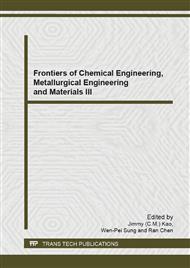p.154
p.158
p.169
p.173
p.178
p.185
p.189
p.193
p.196
Effects of Compound Probiotics on Growth Performance, Intestinal Microflora and Immune Function of Broilers
Abstract:
This study aimed to investigate the efficacy of compound probiotics on broiler performance, intestinal microflora, immune function and serum biochemical indicators. Four hundred one-d-old female broiler chickens were randomly divided into 4 groups with 4 replicates in each group and 25 chickens per replication. The chickens in groupI(control group) were fed a basal diet, experimental groups II, III and IVwere fed the basal diet supplemented with 0.1%, 0.2% and 0.4% compound probiotics. The results of this work were as follows: (1) during the experimental period, compared with control group, the average daily in group III was significantly increased (P<0.05), the feed/gain and average daily feed intake were significantly lower (P<0.05); (2) at the age of 14 and 28 days, the number of cecal Lactic acid in group II and III were significantly higher than the control (P<0.05) and the content of E.coli has the opposite results. (3) the anti-body titer in group III was the highest, and significantly higher compared to the control (P<0.05), but there were no significantly differences between group IV and control group (P>0.05). (4) serum biochemical indexes of broilers in group III and IVwere significantly increased than that in control group (P<0.05). In conclusion, the supplementation of 0.2% compound probiotics could promote the growth performance, improve the cecal mico-ecosystem, enhance the anti-body titer and biochemical indexes in serum.
Info:
Periodical:
Pages:
178-184
Citation:
Online since:
August 2014
Authors:
Price:
Сopyright:
© 2014 Trans Tech Publications Ltd. All Rights Reserved
Share:
Citation:


